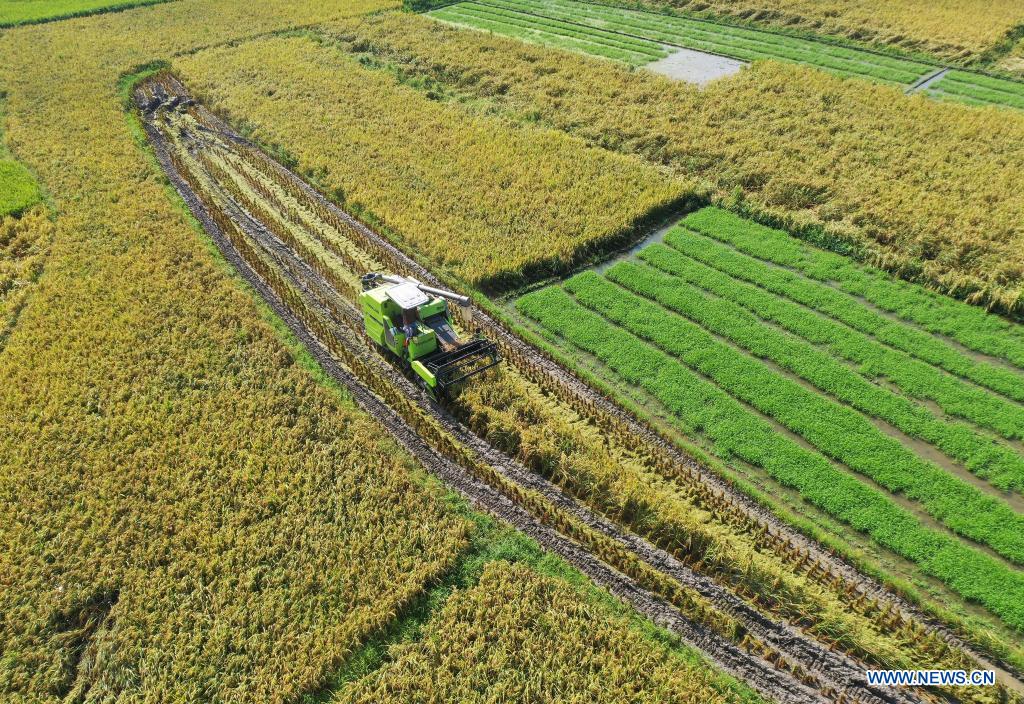Upgrading of grain growing areas to cost 22 billion yuan
China has earmarked 22 billion yuan ($3.4 billion) this year to build high-standard farmland for grain production around the country, an official said.
China has earmarked 22 billion yuan ($3.4 billion) this year to build high-standard farmland for grain production around the country, an official said.

Aerial photo taken on July 20, 2021 shows a harvester reaping rice in the field in Baishizhai village, Shouyan township, Daoxian county of Yongzhou city, Central China's Hunan province. [Photo/Xinhua]
That is a year-on-year increase of 33 percent, said Qiu Tianchao, who oversees the rural economy at the National Development and Reform Commission.
The central government will keep ramping up investment in such projects and tighten oversight of funds to promote food security and the supply of key agricultural products, he told a news conference in Beijing on Thursday.
The State Council Information Office recently released a 10-year plan on establishing more high-standard farmland for large-scale mechanical farming.
The plan said the country had built 53.3 million hectares of such farmland by the end of last year and aims to bring the total area to 80 million hectares by 2030.
Vice-Minister of Agriculture and Rural Affairs Zhang Taolin told the news conference that by then, such farmland will be able to supply around 600 million metric tons of food, which is equivalent to 90 percent of current food production capacity.
China will also upgrade its existing high-standard farmland, an equally important task that will help form a safety net for the nation's food supply that is "of higher quality, more efficient and sustainable", he said.
Zhang said the cost of establishing high-standard farmland will be around 45,000 yuan per hectare.
Based on large blocks of permanent farmland and equipped with high-quality soil and efficient irrigation facilities, the newly built high-standard grain growing areas are expected to increase yields by 10 to 20 percent and cut costs by 7,500 yuan a hectare.
Existing high-standard grain growing areas are spread across seven regions, including northeastern provinces, the lower reaches of the Yangtze River and the parts of the Tibet autonomous region. Those regions will also be the focus of efforts to establish new high-standard farmland.
High-standard farmland has played a crucial role in stabilizing domestic food production in recent years, making it more resilient in the face of disruptions such as those caused by the COVID-19 pandemic, Zhang said.
Guo Yongtian, the head of the ministry's farmland construction and management department, said high-standard farmland has higher rates of mechanization.
"Generally, the mechanization rate is around 15 to 20 percentage points higher than for non-project farmland," he said.
According to data from the third National Land Survey published last month, China had a total of 127.8 million hectares of farmland. Zhang said about 70 percent is of medium or low quality, making it more vulnerable to the impact of disasters such as droughts and floods.
"With a growing population and an upgrading of its consumption structure and people's nutrition, China's grain demand will keep increasing," he said. "Coupled with the impact of uncertain factors such as pests and diseases and natural disasters, China cannot afford to take food security lightly."

